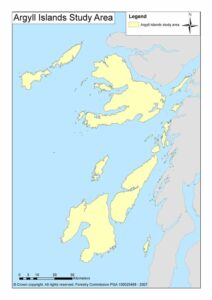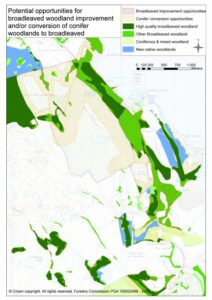Research
Research Status:completed
We use some essential cookies to make this website work.
We’d like to set additional cookies to understand how you use forestresearch.gov.uk, remember your settings and improve our services.
We also use cookies set by other sites to help us deliver content from their services.
 Background
BackgroundWoodland on the Argyll Islands consists of:
Ravines are important for providing sheltered conditions which allow woodland to flourish despite the climate. The oceanic climate and the wide range of soil types result in a great diversity of native woodland types and often in rich assemblages of oceanic woodland ferns and lower plants.
Woodland is also restricted by the presence of mires and other wet soils which, combined with the wet and windy climate, effectively preclude tree growth. Exposure, poor soils and sometimes past management practices combine on some islands to give extensive areas without trees. On some islands agricultural activity is widespread, and tree cover is restricted because of this.
This project provides information about native woodland expansion and restoration opportunities on the Argyll Islands to:
The network analysis for the Argyll Islands required:
Forest Habitat Networks in the Argyll Islands (PDF-203K)
The functional connectivity of existing networks indicated opportunities for their improvement, expansion, or linkage, and where to gain landscape-scale biodiversity benefit from converting coniferous stands to native broadleaved woodland:


Map A

Map B
This approach considered the importance of open ground habitats and ensured the targeting of land most suitable for woodland establishment. Land considered unsuitable for woodland and excluded from expansion and linkage opportunities included areas of high wind exposure, peat bog, and sites designated for conservation (e.g. wetland, geological, and aquatic habitats).
Cookies are files saved on your phone, tablet or computer when you visit a website.
We use cookies to store information about how you use the dwi.gov.uk website, such as the pages you visit.
Find out more about cookies on forestresearch.gov.uk
We use 3 types of cookie. You can choose which cookies you're happy for us to use.
These essential cookies do things like remember your progress through a form. They always need to be on.
We use Google Analytics to measure how you use the website so we can improve it based on user needs. Google Analytics sets cookies that store anonymised information about: how you got to the site the pages you visit on forestresearch.gov.uk and how long you spend on each page what you click on while you're visiting the site
Some forestresearch.gov.uk pages may contain content from other sites, like YouTube or Flickr, which may set their own cookies. These sites are sometimes called ‘third party’ services. This tells us how many people are seeing the content and whether it’s useful.
